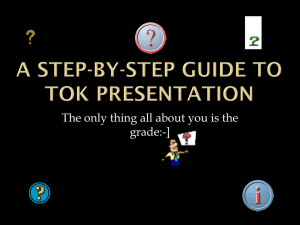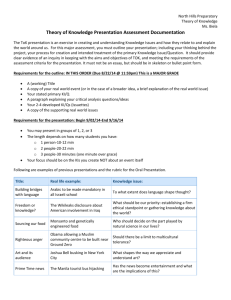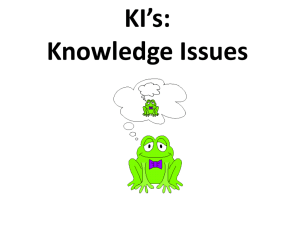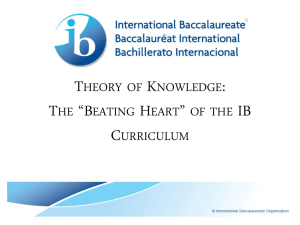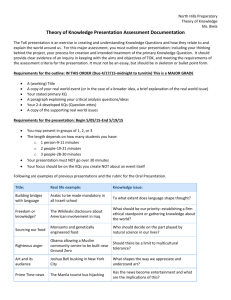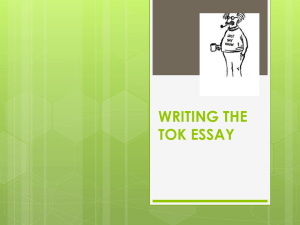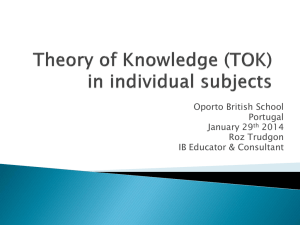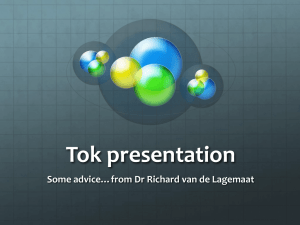File
advertisement
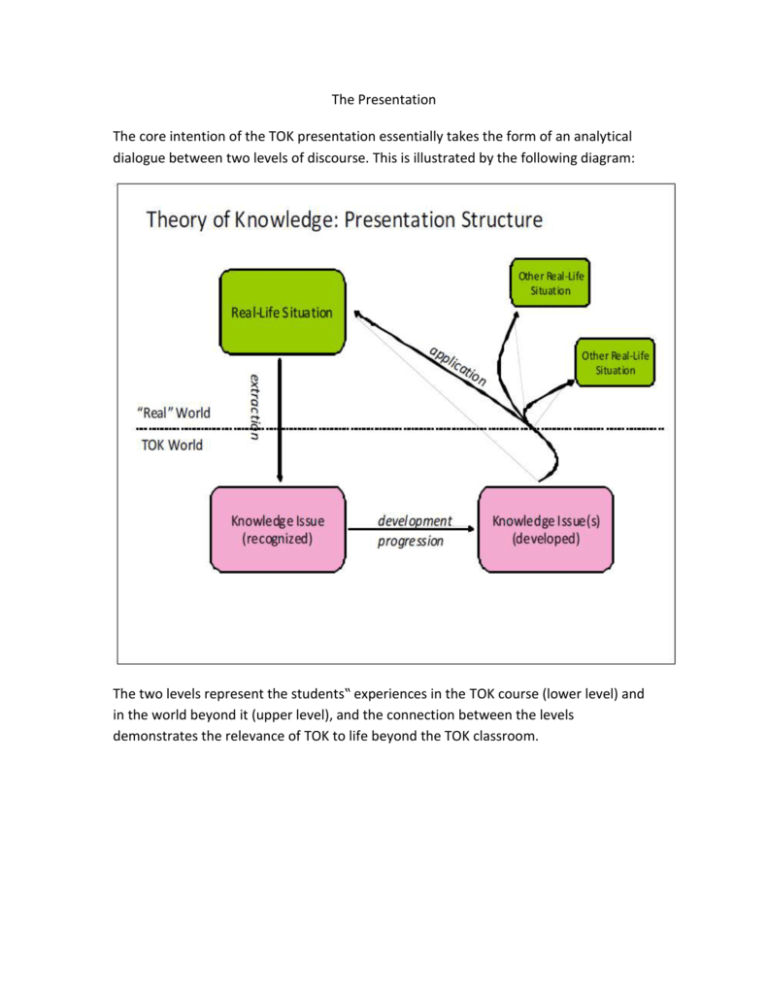
The Presentation The core intention of the TOK presentation essentially takes the form of an analytical dialogue between two levels of discourse. This is illustrated by the following diagram: The two levels represent the students‟ experiences in the TOK course (lower level) and in the world beyond it (upper level), and the connection between the levels demonstrates the relevance of TOK to life beyond the TOK classroom. At the “real world” level, we have the real-life situation from which a knowledge issue (note that “knowledge issue” here is singular, corresponding to Criterion A: Identification of knowledge issue) must be extracted. This knowledge issue, residing in the “TOK world”, must be developed using ideas and concepts from the TOK course, and in this progression it is likely that other related knowledge issues will be identified (note that “knowledge issues” here is plural, corresponding to Criterion B: Treatment of knowledge issues) and will play a part in taking the argument forward. The product of this reflection can then be applied back to the real-life situation at the “real world” level. In addition, the presentation should be able to show how the process of application extends beyond the original situation to others, thus demonstrating why the presentation is important and relevant in a wider sense. Reminder of the assessment criteria A Identification of knowledge issue • Did the presentation identify a relevant knowledge issue involved, implicit or embedded in a real-life situation? B Treatment of knowledge issues • Did the presentation show a good understanding of knowledge issues, in the context of the real-life situation? C Knower's perspective • Did the presentation, particularly in the use of arguments and examples, show an individual approach and demonstrate the significance of the topic? D Connections • Did the presentation give a balanced account of how the topic could be approached from different perspectives? • Did the presentation show how the positions taken on the knowledge issues would have implications in related areas? • In awarding the higher achievement levels, the emphasis should be more on the quality of the consideration of connections than on the quantity of connections mentioned 5 points for each: total = 20 points Component grade boundaries Grade: Mark range: E 0–8 D 9 – 12 C 13 – 15 B 16 – 18 A 19 - 20 Nature of the TOK Presentation Misunderstanding about the nature of the presentation task persists in some schools. One verifier commented: “the vast majority of presentations I viewed were simple recitations of two sides of a controversial issue, with no attention to how the contrasting beliefs had been formed as the result of a process of learning. Many of these would have been competent – even excellent – presentations in another course (politics, history, sociology), but they were not appropriate for TOK, and in some cases were almost entirely irrelevant. Even more distressing was the fact that in most cases, the teachers had given these presentations high marks on all four criteria.” Verifiers are deeply concerned about viewing so many presentations in which students clearly invest much time and effort, but do so to little effect as the outcomes are almost entirely descriptive and lacking in analysis. This is a problem of relevance. We cannot stress strongly enough; the TOK presentation is NOT a descriptive research project; NOT a social studies “report” on some subject of general interest. Without a focus on Knowledge Issues presentations cannot deserve major credit on the assessment criteria (criteria A and B are almost certain to score zero for research projects, and a very low mark for D is very likely). They can be very good presentations, but are very poor TOK presentations. It is strongly recommended that the construction by the students of a diagram like the one above, adapted to the individual nature of the planned presentation, be made a part of the planning process. A structured diagram of this sort would ideally be drawn on the reverse side of the TK/PPD form, and would encourage an analytic exploration of Knowledge Issues which would likely result in the award of high marks. Delivery of TOK Presentation The presentation must not be delivered from a script – while flashcards and other prompts are likely to be helpful, these must be subordinated to the primary nature of the TOK presentation as an exercise in speaking While interactions with the audience are permitted during the presentation, they must be well-planned and not act as a substitute for clear thinking on the part of the presenters. Discussion after the end of the presentation is not considered a part of the presentation and should not influence assessment judgements The use of movie and YouTube clips must similarly be subordinated to the overall aims of the presentation and not be used as substitutes for thinking and analysis. It is expected that the presentation be a live event to the extent that video material does not become the dominant mode of delivery While the instructions in the Subject Guide allow for group presentations up to a group size of 5 candidates, “it seemed to [us] that the ideal group size was two or three students – individual presentations were heavily constrained by time, and groups of four or five tended to produce scattered or repetitive work”. Just as good writing enhances the clarity and persuasiveness of an essay, good speaking skills, while not part of the formal assessment, can enhance a presentation. Material that cannot be heard clearly cannot attract credit and cannot contribute to understanding The principles of academic honesty must be observed and the need for acknowledgement recognized even in the oral context of the presentation There follow a few examples of topics for presentations viewed this year – intended to illustrate some common generic pitfalls and how they might be avoided. ****** Problem: the presentation is not grounded in real people and real life Example topic: If everyone in the world could kill one person, what would happen? This is, happily, an entirely hypothetical question. It might be possible to develop knowledge issues in line with various ethical theories through an analysis of possible scenarios arising from the initial question. But crucially there is no real-life situation to ground the presentation, and no single clearly-expressed knowledge issue that would focus the treatment. The presentation is likely to appear quite detached from real life – it might constitute an intriguing thought experiment, but its application to how we go about our daily lives is likely to be tenuous at best. Such a presentation would tend to meander in the lower level of the presentation structure diagram. ***** Problem: the presentation is focused on a description of a real event or situation to the exclusion of analysis Example topic: Post-traumatic stress disorder in Rwanda after the 1994 genocide This might be a fascinating and important topic, but it is not immediately clear how it is related to TOK. In order to make the crucial connection, the presentation could focus on the process of diagnosis and the challenges psychiatrists face in gaining reliable knowledge about patients. But this may be not at all what the candidate really wants to talk about! If the candidate merely wants to describe the events of 1994 and their aftermath, especially if s/he has personal experiences related to them, this could be a captivating presentation, but it will be a very poor TOK presentation because it resides exclusively at the upper level of the presentation structure diagram. ***** Problem: the presentation uses TOK concepts and vocabulary entirely superficially, or simply as “markers” for TOK Example topic: The logic behind the school’s security policy Such a topic would presumably have to examine the quality of reasoning provided in support or in criticism of the policy, and this analysis would have to be focused by a single knowledge issue. But if the candidate’s main intention is just to recite the arguments for and against the status quo, then the nature of logic and its applications have not been addressed. This would be an example of a presentation that resides entirely at the upper level of the presentation structure diagram. ***** Problem: the presentation concerns itself with an ethical topic introduced as a twosided debate in which the presenter in the end abstains from judgment Example topic: Is the death penalty ethical? Topics of this kind may prompt candidates to lay out arguments for and against and then declare that in the end we are all entitled to our own individual opinions. Once again, the quality of support for various positions needs to be evaluated in order to promote a sense of progress in the presentation. There needs to be a focus on a particular event or situation – a sentence carried out or a law passed or repealed, or an impassioned speech made – in order to satisfy fully the requirement for a real-life situation. If this is not the case, the presentation will fail on two counts – no reference to the upper level of the diagram (no real-life situation) and no proper treatment of knowledge issues (lower level of the diagram). In the words one verifier: “having settled on a controversial issue, it is then perilously easy to fall into the trap of simply reiterating the reasons that proponents of either side offer in support of their point of view. This in turn creates a false sense of security because students talk about “reasons” and “ethics” and assume that the use of those terms constitutes the investigation of a knowledge issue. Listing reasons, however, does not constitute an investigation into how one came to believe in those reasons, and stating that the controversy is a matter of ethics does not constitute an investigation into how the ethical stance was developed and internalized”. The following real-life situations were used in presentations this year – these examples are included here because they lend themselves to effective knowledge issues as indicated: Real life situation: A controversial exhibition in an art gallery Knowledge Issue: To what extent are the limits of art defined by morality? Real life situation: Claim in a biology textbook that mesosomes are not real structures in bacteria Knowledge Issue: How can we be sure that scientific evidence gained through the use of technology is genuine? Real life situation: A move to make history a compulsory school subject up to age 16 Knowledge Issue: To what extent should academic disciplines be ranked according to their usefulness? Real life situation: The use of a personality test to assess students in the class Knowledge Issue: What are the strengths and limitations of quantification in the human sciences?
